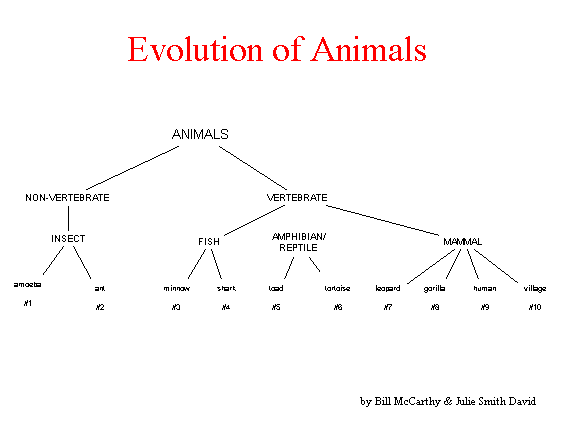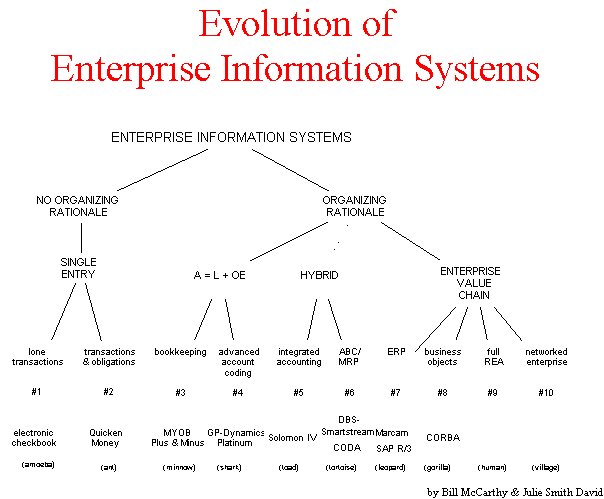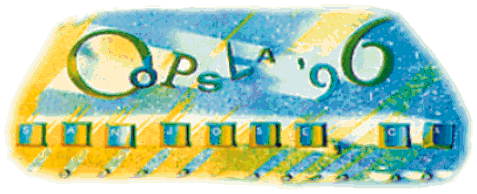The Evolution of Enterprise Information Systems --
From Sticks and Jars Past Journals and Ledgers Toward Interorganizational
Webs of Business Objects and Beyond
William E. McCarthy, Michigan State University, 21277wem@msu.edu
Julia Smith David, Arizona State University, julie.smith.david@asu.edu
Brian S. Sommer, Andersen Consulting, brian.s.sommer@ac.com
Comments:
The semantic distance between the reality of a business
enterprise and its implemented model -- its information system -- has slowly
decreased as measurement techniques, representation models, and computer
technology have progressed. Thousands of years ago, economic matters were
tracked by artifacts such as notched sticks and clay jars which stored
imprinted figures (Dunn and McCarthy, 1992). With these primitive tools,
transaction data was recognized and recorded, but without any overarching
economic rationale. With advances in arithmetic and writing/printing technology,
and dramatic changes in the business environment, investors required some
kind of overall periodic judgment of the success of efforts such as a shipping
venture or a manufacturing endeavor. These changes put pressure on the
dominant class of systems, and over time, the accepted information systems
became ill-adapted to the emerging environment.
At some point, an evolutionary mindset would predict the emergence and
flourishing of new types of information systems. In fact, this did occur
in 1494 when Luca Pacioli rectified the unorganized state of affairs for
commercial undertakings with the advent of double-entry bookkeeping. A
bookkeeping model represents economic reality with the classificational
artifacts of accounts which are actually successively refined divisions
of one monetary equality (Assets = Liabilities + Equity). This scheme remains
common today, and with it, increasing complexity and faster-paced reaction
needs are most often accommodated by finer and finer account partitions,
an awkward adaptation made somewhat viable by spreadsheet technology, but
nonetheless very clumsy. Pacioli's framework served businesses well for
over 400 years, but the enabling technology of computers and increasing
organizational complexity resulted in an environment that produced adaptations
like materials requirements planning systems which supplemented the entrenched
ledger-oriented software.
More recently, the competitive pressures of faster cycle times and a
worldwide information-driven business environment are forcing even more
dramatic changes. These evolutionary shifts are reflected in the marketplace
of business software where new enterprise information systems are supplanting
general ledger and other accounting-oriented modules in many companies.
The advent of ERP (Enterprise Resource Planning) systems like SAP's R/3
is an example of the new "species" of information systems. ERP
systems are not bookkeeping driven, but are instead organized around the
basic economic rationale of the enterprise value chain -- a process view
of a business that regards all transactions as steps in a value accumulation
sequence which provides a firm's customers with a final portfolio of desirable
product attributes. This movement away from inflexible accounting artifacts
and towards adaptable representations of enterprise value chains would
also predict the increasing emergence of business object frameworks where
the semantic distance between an economic reality (an enterprise) and the
computer representation of that reality decreases even more dramatically.

Figure 1
In this paper, we take the evolutionary changes described above and
put them in a formal analysis and classification framework patterned after
biological evolution. Our biological and software frameworks are displayed
in hierarchical form on Figures 1 & 2. The following discussion points
provide an overview of the five major categories of enterprise information
systems that have evolved in the past and could emerge in the future (the
comparable biological species are shown in parentheses).
- The economic tracking systems with no overall organizing rationale
(the simple one-celled organisms and the insects) -- These are
information systems that simply accumulate transaction data. Some of the
more advanced of these species do match economic obligations (like paying
a bill with a check) but they do not have any macro-organization. These
are our #1-2 systems. Quicken is a prototype #2 (insect) system.
- The accounting systems that are organized around the classic
A=L+OE equation of double-entry bookkeeping (the fish) -- These
marine species exist in an environment where accounting needs and conventions
pre-empt all others, and all other decision-makers are relegated to either
massaging the bookkeeping interpretations of reality or reprocessing the
transaction data by themselves. Early MRP systems were examples of this
latter case as operations managers were often forced to develop separate
information systems to be used to supplement accounting measurements. Fish
can be made more powerful by exploding the account classification schemes
(in some cases leading to over a half million or more accounts with very
long general ledger codes). However, they can't survive well out of water
(where most of the worldwide economic action is taking place). The Peachtree
systems are classic small fish or minnows, while any of the mainframe G/L
suites (with accompanying A/P, A/R, Payroll, Job Cost, etc.) that facilitate
exploding account hierarchies are prototypical big fish or sharks. Sharks
clearly rule certain types of environmental niches, and they will continue
to do so for some time. Their future, however, is just as clearly restricted.
- The application software suites which still service accounting
conventions but which also try on a somewhat equal basis to meet the needs
of managers in operations, logistics, human resources, finance, engineering,
etc. (the amphibians and reptiles) -- These species include those
software suites which were clearly anchored on ledger ideas once upon a
time, but which presently are moving toward an enterprise orientation.
In these categories, ABC (activity-based costing) and ABM (activity-based
management) conventions are used in an attempt to mitigate the distorting
effects that traditional transaction tracking and costing schemes have
on enterprise models. Full value-chain organization and analysis is lacking
however, and separated accounting, manufacturing, distribution, and marketing
systems still remain the norm. Software suites that we would tentatively
slot here would be those offered by Dodge and Dunn & Bradstreet.
- The enterprise-oriented software packages and models (the mammals
or fully-developed terrestrial species) -- The top-end ERP systems
such as those offered by SAP reside in this category where their enterprise
orientation aims to integrate accounting transaction processing with workflow,
design, and engineering management. ERP (leopard) systems bring a heavy
price in terms of complexity however. They are monolithic and inflexible;
the typical business that commits to ERP is committing itself to a process
and organizational vision which may not quite fit its reality exactly.
Thus, we see the opportunity for successful adaptations in the near term
future, adaptations which retain the enterprise perspective, but which
look to a much simpler and more flexible implementation. According to Sutherland
(1995), this simpler vision would consist of business objects whose use
could lessen the distance between systems analysis efforts and actual system
design and implementation. Within such an environment, the plug-and-play
modules become highly semantic, interoperable components that can be customized
to model a particular enterprise as close as possible to its actual way
of doing business. This is the CORBA vision for business objects. At an
even higher semantic level, we would propose conceptual models of enterprise
value creation based on microeconomic and accounting theory as the ultimate
abstract vision toward which systems in the 7-8 categories should move.
The REA enterprise model (described in object milieu by Geerts and McCarthy
(1996)) is the most widely-accepted example of such a conceptual framework.
Thus, as an idea whose full implementation relies on technology yet to
be completely developed, REA systems become our sole example in the #9
(human) category.
- Interorganizational systems which record transactions in one
centralized fashion and make the data available to all parties (inter-enterprise
and intra-enterprise) participating in economic exchanges or interested
in their results (a village) - As the business community embraces
globalization, increased pressures for customization, improved service
levels, and reduced costs, firms are being forced to work more closely
with others in their value system. They are striving to coordinate activities,
specialize efforts to capitalize on expertise, and eliminate any waste
from the system. As a result, these firms all need to share more information
with organizations they have historically tried to keep at an arm's-length
distance. For example, Wal-Mart is widely recognized for its supplier management
system which enables suppliers to use live store-level sales and inventory
data. Similar to a hive of bees or a human community, firms are demanding
higher levels of sentience from their computer applications; they need
systems that recognize that multiple organizations with varied perspectives
are relying on their information. Therefore, these systems must capture
economic transactions in a form that can be translated to any who require
information. Although in their evolutionary infancy, we predict that the
most successfully adapted village systems will not be those that build
a "school of fish" because of the inherent weaknesses induced
by these systems artificially filtering data at the time of transaction
occurrence and by their highly syntactic coding schemes Therefore, we believe
the future will be the village of mammals: systems built on rich semantic
foundations that allow users to filter the data to meet their own requirements.
Our predicted evolutionary emergence of highly sentient and highly interconnected
enterprise models is of course open to speculation on its validity. For
example, some analysts might contend that present-day ERP packages do not
actually contain the full models of enterprise value chains that they purport
to comprise; instead they are idiosyncratic amalgams of accounting-driven
software solutions for different parts of a company. This makes them highly-developed
reptiles instead of mammals, and if we suppose that the same present-day
market demands for interconnectivity discussed above causes them to be
used across organizational boundaries, it might be the case that non-abstract,
non-conceptual, and non-object-oriented solutions could be proposed and
used extensively in the software marketplace. Like the dinosaurs of yore,
however, we would believe that the limited semantics of such suites would
eventually cause them to lose out to their more knowledge-based competitors.
As a final note to this preliminary outline, we would like to emphasize
that just like the biological species of Figure 1, our species of enterprise
information systems being arranged in a hierarchy does not mean that the
lower order species are not more dominant in some restricted ways. Insects
and one-celled animals thrive today, and Quicken (and its clones) thrives
as well. In fact, it might be possible for some of the more appealing features
of Quicken to take an evolutionary leap over the 3-6 systems to be united
with enterprise-oriented systems and ultimately with inter-enterprise systems.
Those appealing features are its ease of use, its simplicity of operation,
and its close correspondence to the manual tasks it replaces -- an evolutionist
would call these the traits that account for its reproductive fitness --
and it would be difficult with present technology to see them implemented
for enterprise systems with extremely high transaction loads. However,
as process and storage costs continue to decrease and as object-oriented
analysis methods become more refined, the selective seeding of those features
onto 7-8 systems becomes more feasible.

Figure 2
REFERENCES
Dunn, Cheryl L. and William E. McCarthy (1992). Conceptual Models of
Economic Exchange Phenomena: History's Third Wave of Accounting Systems.
Collected Papers of the Sixth World Congress of Accounting Historians,
Kyoto, Japan. Volume I, pp. 133-164.
Sutherland, Jeff (1995). "Business Object Design and Implementation."
in 10th Annual Conference on Object-Oriented Programming Systems, Languages,
and Applications Addendum to the Proceedings. OOPS Messenger 6:4:170-175.
ACM/SIGPLAN October, 1995.
Geerts, Guido and William E. McCarthy (1996).
"Modeling Business Enterprises as Value-Added Process Hierarchies
with Resource-Event-Agent Object Templates" in
Business Object Design and Implementation,
Jeff Sutherland and Dilip Patel (eds.), Springer-Verlag.
McCarthy, William E., Julia Smith David, and Brian
S. Sommer (1996). The Evolution of Enterprise Information Systems,
paper in progress (available in November-December 1996 upon request).
 Business
Object Workshop II
Business
Object Workshop II Business
Object Workshop II
Business
Object Workshop II

 Business
Object Workshop II
Business
Object Workshop II